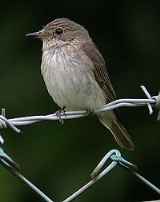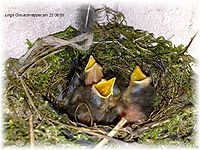
Spotted Flycatcher
Encyclopedia
The Spotted Flycatcher, Muscicapa striata, is a small passerine
bird in the Old World flycatcher
family. It breeds in most of Europe
and western Asia
, and is migratory
, wintering in Africa
and south western Asia
. It is declining in parts of its range.
This is an undistinguished looking bird with long wings and tail. The adults have grey-brown upperparts and whitish underparts, with some streaking on the breast. The legs are short and black, and the bill is black and has the broad but pointed shape typical of aerial insectivores. Juveniles are browner than adults and show the spots on the upperparts which give this species its name.
Spotted Flycatchers hunt from conspicuous perches, making sallies after passing flying insects, and often returning to the same perch. Their upright posture is characteristic.
They are birds of deciduous woodlands, parks and gardens, with a preference for open areas amongst trees. They build an open nest in a suitable recess, often against a wall, and will readily adapt to an open-fronted nest box. 4-6 eggs are laid.
Interestingly, most European birds cannot discriminate between their own eggs and those of other species. The exception to this are the hosts of the Common Cuckoo
, which have had to evolve this skill as a protection against that nest parasite. Spotted Flycatcher shows excellent egg recognition, and it is likely that it was once a host of the Cuckoo, but became so good at recognising the intruder's eggs that it ceased to be victimised. A contrast to this is the Dunnock
, which appears to be a recent Cuckoo host, since it does not show any egg discrimination.
Spotted flycatchers exhibit an atypical molt strategy, that is they molt their primaries and some of their secondaries in the reverse order from what is seen in most passerines.
The flycatcher's call
is a thin, drawn out soft and high pitched tssssseeeeeppppp, slightly descending in pitch.

Passerine
A passerine is a bird of the order Passeriformes, which includes more than half of all bird species. Sometimes known as perching birds or, less accurately, as songbirds, the passerines form one of the most diverse terrestrial vertebrate orders: with over 5,000 identified species, it has roughly...
bird in the Old World flycatcher
Old World flycatcher
The Old World flycatcher family Muscicapidae is a large family of small passerine birds mostly restricted to the Old World. These are mainly small arboreal insectivores, many of which, as the name implies, take their prey on the wing.-Characteristics:...
family. It breeds in most of Europe
Europe
Europe is, by convention, one of the world's seven continents. Comprising the westernmost peninsula of Eurasia, Europe is generally 'divided' from Asia to its east by the watershed divides of the Ural and Caucasus Mountains, the Ural River, the Caspian and Black Seas, and the waterways connecting...
and western Asia
Asia
Asia is the world's largest and most populous continent, located primarily in the eastern and northern hemispheres. It covers 8.7% of the Earth's total surface area and with approximately 3.879 billion people, it hosts 60% of the world's current human population...
, and is migratory
Bird migration
Bird migration is the regular seasonal journey undertaken by many species of birds. Bird movements include those made in response to changes in food availability, habitat or weather. Sometimes, journeys are not termed "true migration" because they are irregular or in only one direction...
, wintering in Africa
Africa
Africa is the world's second largest and second most populous continent, after Asia. At about 30.2 million km² including adjacent islands, it covers 6% of the Earth's total surface area and 20.4% of the total land area...
and south western Asia
Asia
Asia is the world's largest and most populous continent, located primarily in the eastern and northern hemispheres. It covers 8.7% of the Earth's total surface area and with approximately 3.879 billion people, it hosts 60% of the world's current human population...
. It is declining in parts of its range.
This is an undistinguished looking bird with long wings and tail. The adults have grey-brown upperparts and whitish underparts, with some streaking on the breast. The legs are short and black, and the bill is black and has the broad but pointed shape typical of aerial insectivores. Juveniles are browner than adults and show the spots on the upperparts which give this species its name.
Spotted Flycatchers hunt from conspicuous perches, making sallies after passing flying insects, and often returning to the same perch. Their upright posture is characteristic.
They are birds of deciduous woodlands, parks and gardens, with a preference for open areas amongst trees. They build an open nest in a suitable recess, often against a wall, and will readily adapt to an open-fronted nest box. 4-6 eggs are laid.
Interestingly, most European birds cannot discriminate between their own eggs and those of other species. The exception to this are the hosts of the Common Cuckoo
Common Cuckoo
The Common Cuckoo is a member of the cuckoo order of birds, Cuculiformes, which includes the roadrunners, the anis and the coucals....
, which have had to evolve this skill as a protection against that nest parasite. Spotted Flycatcher shows excellent egg recognition, and it is likely that it was once a host of the Cuckoo, but became so good at recognising the intruder's eggs that it ceased to be victimised. A contrast to this is the Dunnock
Dunnock
The Dunnock, Prunella modularis, is a small passerine bird found throughout temperate Europe and into Asia. It is by far the most widespread member of the accentor family, which otherwise consists of mountain species...
, which appears to be a recent Cuckoo host, since it does not show any egg discrimination.
Spotted flycatchers exhibit an atypical molt strategy, that is they molt their primaries and some of their secondaries in the reverse order from what is seen in most passerines.
The flycatcher's call
Birdsong
Birdsong may refer to:* Bird vocalization, the sounds of birds* Birdsong , a 1993 novel by Sebastian Faulks* Birdsong, Arkansas, USA* Birdsong , a channel on the UK Digital One digital radio multiplex...
is a thin, drawn out soft and high pitched tssssseeeeeppppp, slightly descending in pitch.

Identification
- Bradshaw, C., P. J. Jepson and N. J. Lindsey. (1991) Identification of brown flycatchers British BirdsBritish Birds (magazine)British Birds is a monthly ornithology magazine that was established in 1907. It is now published by BB 2000 Ltd, which is wholly owned by The British Birds Charitable Trust , established for the benefit of British ornithology...
84(12):527-542
- Alström, Per & Erik Hirschfeld (1991) Field identification of Brown, Siberian and Grey-streaked Flycatchers Birding WorldBirding WorldBirding World is a monthly birding magazine published in the United Kingdom. It is the magazine of the Bird Information Service, based at Cley next the Sea, Norfolk....
4(8):271-278
External links
- Spotted Flycatcher videos, photos & sounds on the Internet Bird Collection
- Ageing and sexing (PDF) by Javier Blasco-Zumeta

